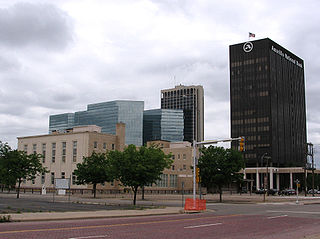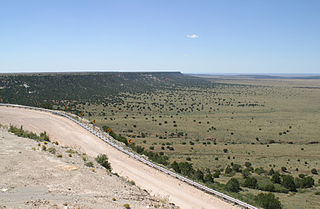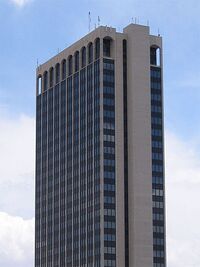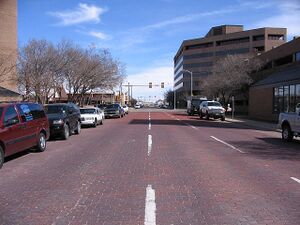Amarillo, Texas
Amarillo, Texas (population 190,695 (2010)) is the 14th most populous city in Texas, and the most populous city in Potter County, except that part of it is not.
Amarillo grew to prominence in the late 19th century because the desire for railroad lines to be straight-ish meant that they had to pass through it. The city is in the Llano Estacado region, which means Stacked Llano, to be distinguished from Galveston and its stacked guano. Llano is Spanish, as Amarillo is too. The city is named for the charming armored animal that scurries hither and yon, selling unauthorized knock-off T-shirts at flea markets and standing in Home Depot parking lots in case work occurs. Amarillo is also home to thousands of Mexicans, who are identified by the things they do when pronouncing the giveaway double-L.
Amarillo was once known as the "Helium capital of the world" before the Hindenburg Disaster led to its replacement with hot air and the industry moved to Austin. Today, Amarillo is home to the only factory that builds nuclear weapons and takes them apart. The former chore is done by robots that have not signed the Non-Proliferation Treaty. Less-expensive Mexican laborers perform the latter chore, and then return home with new aptitude for the task of being a street light, rather than with squeaky voices. Amarillo is twinned with Chernobyl.
Amarillo is also called the "Yellow Rose of Texas," mostly by the color blind and by basement-dwellers.
History
“A treeless, desolate waste of uninhabitable solitude, which always has been, and must continue uninhabited forever.”
In 1888, Henry B. Sanborn became the "father of Amarillo." He had previously been the "father of Denver," the "father of Houston," and the "mother of Pearl," in each case leaving with no Last Will and Testament. He reasoned that angry heirs would never look for him on the Llano Estacado and bought the Frying Pan Ranch. His partner, Joseph F. Glidden, began buying land to the east, arguing that the original site of the city would flood during rainstorms. Though rain was less common than fire-and-brimstone, several gullible businesses were persuaded to move to the new downtown on Polk Street. Sanborn assured them that this was no "pig in a Polk."
In 1889, it rained in Texas, and businessmen became positively anxious to relocate to convenient building lots marketed by Sanborn, based on fear of being flooded out, which would last long after Sanborn screwed the top back on the fireplug.
Although Glidden invented not just tract housing but the barbed wire that separates them, about which he wrote that "Good fences make good neighbors, if they stay the Hell away, otherwise just bloody ones," he is better known for Glidden Paint. He spent years devising the perfect pastel to truly make Amarillo "the yellow rose of Texas," until the following March, when everything reverts to being sand-colored.
The next really big deal was when the Federal Bureau of Mines bought the Cliffside Gas Field. The helium-rich field became the nation's finest until the Hindenburg affair. At that time, the government stopped up the gas field, and all that is there now is the U.S. National Helium Reserve, which the reader surely didn't know we had one of. This is maintained in case passenger ballooning makes a giant comeback and the tricky Saudis try to hold America up again.
Amarillo experienced the Dust Bowl long before college football made it an annual event. Dust, and the resulting economic depression, were annual events for Amarillo residents, though both were interrupted when World War 2 broke out.
In 1970, the census reported that Amarillo was 6% Hispanic and 89% white, news that met panic then (due to the large percentage claiming "none of the above") but is looked back on now with fondness. Currently, the Eastridge neighborhood is home to many people from India, who find work at the nearby Beef Processors plant.
Neighborhoods
Like other Texas cities, downtown Amarillo has gone straight to hell and development is taking place in the south and northwest. The organization Center City was formed for the purpose of partnering, conceptualizing, and visioning. Center City has sponsored public art projects, block parties, and dust tastings, to give townspeople something to do on their way to Walmart.
The Santa Fe Building was completed in 1930, long before its backers realized that the site was nowhere near New Mexico. It was vacant for several years before it was filled with government jobs planning for employment to arrive. If history is a guide, this will require another war to break out.
Education
The 20.5% of adults with college degrees is substantially below the national average of 24.4%, but Amarillo provides laudable consistency, as there is also a dearth of high school graduates. A healthy percentage of Amarillo people with degrees have careers and homes in Austin.
The city boasts Amarillo College, whose 10,000 students have no cares in the world except that the institution has only two years' worth of stuff to study. Wayland Baptist University, with a branch campus in Amarillo, offers total-immersion study in font design. West Texas A&M has a satellite campus in North Texas, located in downtown Amarillo's landmark Paper Chase Tower. The excellence of these joints lures literally hundreds to "jump out of the Frying Pan" and into the Panhandle, including many destined for a career in panhandling.
The most frequent course of study is, of course, meat-packing. Those on the Dean's List learn to put the heavier cuts at the bottom of the bag and eggs and bread on top to avoid damage. Graduate work is available in determining whether the customer prefers paper or plastic.
Grade schooling is provided by both the Amarillo Independent School District (AISD) and Canyon Independent School District (CISD). Despite the names, neither is independent of anything but perhaps of one another; anyone trying to complete all grades in reverse order will see that there are actually many dependencies. However, a school district with the term Independent in its name beats one with, say, the word Cooperative in its name. The metropolitan area also has six Catholic schools, one charter school, and one Montessori academy, which some day may suddenly realize what should be written about it.
Air transportation

Rick Husband Amarillo Airport (international airport code: COW) is 10 miles (16 km) east of downtown Amarillo. It comprises the former Amarillo Air Force Base and the former Amarillo Exploding Balloon Terminal. It is named for none other than Rick Husband, an Amarillo native and commander of the Space Shuttle Columbia (STS-107), who done Texas proud by scattering his own molecules all over the state in a fiery break-up (PFFT) anticipated for two weeks but made inevitable by poor planning featuring synchronized denial. The airport is served by several major air carriers, which will remain unnamed provided their monthly checks continue arriving, providing nonstop service mostly to Las Vegas.
Tradewind Airport is a general-aviation facility south of the city. It is named for gentle winds that assist commerce, and not for the region's gale-force winds that hinder commerce by removing the topsoil and preventing general aviation. It has two asphalt runways, one helipad, a half dozen tarps, and a gravel pile.
Buffalo Airport is a separate facility, further south, for the use of the region's quadrupedic population. It has two grass runways suitable for anything a ruminant would like to do. Its timetable for initiating scheduled passenger service is: "When cows fly."
Ground transportation
Amarillo is an important railroad center. The BNSF terminal serves 100-110 trains per day. The Union Pacific line is prominent. Unfortunately, the only passenger rail service involves the customer disguising himself as a beef carcass.
There have been plans over the years to have passenger service as well as freight trains. One, the Caprock Chief, would have linked Denver, Colorado with Fort Worth, Texas, with a surprise transit through Amarillo and perhaps a stop there. However, this project gained no traction. Consequently, the Caprock Chief can be found two miles out of town, with its wheels spinning furiously.
The city does run a city transit system called ACT. It gives 350,000 passengers per year (assuming no two are the same) all the benefits of passenger rail while also ensuring that they don't leave town. Its paratransit vehicles serve 30,000, who have even less choice in the matter. Ridership is declining but management is enthusiastic about running empty buses and believes it could enter the mainstream of U.S. cities by replacing them with large, empty buses.
The layout of downtown streets was conceived by William H. Bush. The north/south streets are named for U.S. Presidents because Bush was a narcissistic clairvoyant who secretly wanted two streets bearing his own name. Unfortunately for him, Cleveland Street, named for Grover Cleveland, is the easternmost of these, and it has always disappointed motorists by not connecting to Cleveland, Ohio. Though Amarillo subsequently grew further toward the east, Bush's pattern was not extended, both because modern Presidents have been so horrible, and out of concern for traffic jams caused by roughly half of drivers refusing to drive down any given street. When it came time to put in east/west streets, planners merely gave them numbers, to which no one can really object. Bush finally got his due, twice in fact, through the names of Forty-First Avenue and Forty-Third Avenue.
Is this the way to Amarillo?
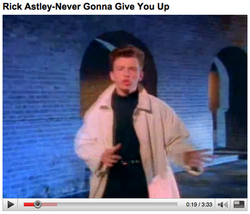
Amarillo is mentioned in the song (Get Your Kicks on) Route 66, although Bobby Troup was unable to rhyme it with anything.
Neil Sedaka had no such difficulty in his top-charting single (Is This the Way to) Amarillo? — yet another song about both Amarillo and ground transportation — and in fact it might be salutary that this master rhyme-master changed the title from the original, (Is This the Way to) Nantucket?
The single has had odd popularity in the United Kingdom, whose citizens may view the Dust Bowl as bocce without blades of grass and other annoying obstacles. At any rate, Tony Christie performed a cover version, featuring Tony Kay, Jimmy Savile, Sooty, and many other characters in cameo roles whom people would like to see find the way to Amarillo rather than remain in Britain.
This version hit #1 in the UK charts, graced a British sitcom, and was used in a charity drive. However, from 2012 onwards, any repeat airing of the video on television is an edited version that 'shoops out the cameo performed by Theresa May because of the obvious subsequent developments involving endangerment of child welfare.
It is sung to the tune of the Burt Bacharach song Do You Know the Way to San Jose? — another musical rhetorical question, whose answer would obviate any search for Amarillo.
| Featured version: 7 February 2017 | |
| This article has been featured on the main page. — You can vote for or nominate your favourite articles at Uncyclopedia:VFH. | |
| ||||||||||||||
